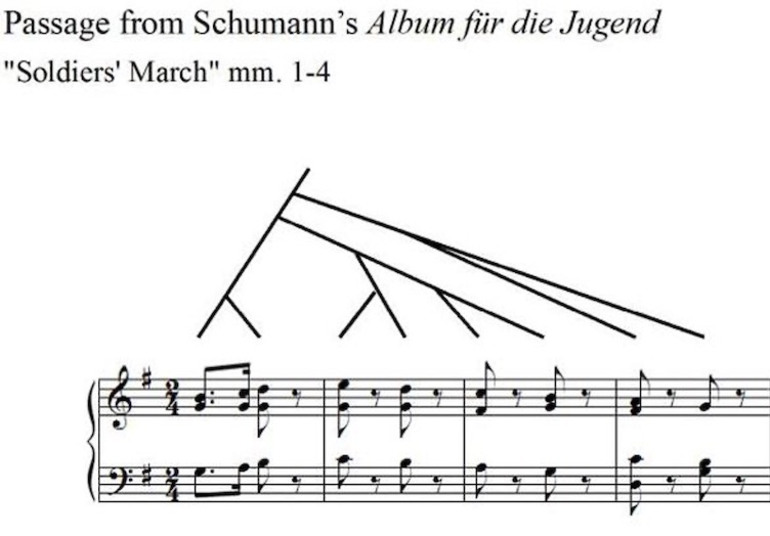Producing
Recently, rhythm research has experienced a new momentum, not least because rhythm is excellently suited as a transdisciplinary research object.
Two rhythm theories
In cognitive sciences as well as in psychology and, of course, in dance, music and art studies, a wide variety of approaches are being developed. Two rather opposing theories face each other:
On the one hand, the cognitive science-based approach divides rhythm into the smallest possible perceptible elements, and then describes how these elements can be combined into ever higher rhythmic units. In music theory, this approach is followed, for example, in the Generative Theory of Tonal Music which had received essential inspiration from linguistics.
Example for a structural analysis of Rhythm: Primitive Hierarchical Processes and the Structure of a Single Note, Conference Paper by Daves Mey, West Coast Conference of Music Theory and Analysis, Santa Barbara, CA on April 9, 2011.
Another approach focuses on the performative (‘experienced’, ‘embodied’) aspect of rhythm: According to this approach, rhythm can only be understood and described as a concrete experience of time due to its temporality. Here, phenomenological and psychological research from the beginning of the 20th century is taken up again. Jin Hyun Kim,3 for example, refers in her research to the philosopher Richard Hönigswald (The Problem of Rhythm): He had already described the problem of the perceptibility of rhythmic figures. For him it is obvious that we do not perceive rhythm as being composed of smallest, determinable elements. Rather, the overall gestalt of rhythm is what we perceive in the first place. But we produce this shape ourselves by experiencing the structured time in time and by structuring it ourselves. This positing of time as a gestalt gives the perceived a new quality which is more than just the sum of measurable units. Only from this quality we derive elementary components and can determine them in their givenness. The coincidence of experienced time and the conscious, knowing experience in time is what, according to Hönigswald, makes rhythm a produced object.
Jin Hyun Kim also questions another theorist about his understanding of rhythm: Aristoxenes. Aristoxenes distinguishes between a passive and an active principle: a formative force – the rhythmising – and the substance to which the rhythm is imprinted (this substance can be sounds, bodies, etc.). However, Aristoxenes does not speak of producing, and especially not in the sense of Hönigswald (as a psychic act); nevertheless, and here it becomes apparent that Aristoxenes was a pupil of Aristotle, the rhythmic principle can only be grasped, or is only "present" at all, when it shows itself in connection with the substance to be rhythmised - i.e. in the concrete bringing forth of the structured time.
Maria Hector


The European Commission's support for the production of this publication does not constitute an endorsement of the contents, which reflect the views only of the authors, and the Commission cannot be held responsible for any use which may be made of the information contained therein.
